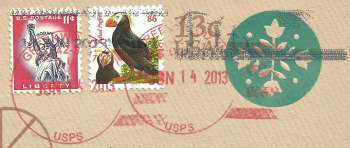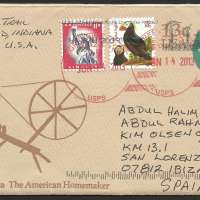STAMP PHILATELY
Spain - Prepaid + Uprated Cover from United States (2013)
GENERAL INFORMATION
Country
United States of America
Type
Postal Cover
Class
Commemorative
Front Inscription
Bicentennial Era The American Homemaker
Postmark
14/06/2013
Postmark Town
Greenwood, Indiana, USA
Gum
Gum
IN COLLECTION CONDITION
Preliminary
Normal
Condition
Used With Postmark - Very Fine
Spain - Prepaid + Uprated Cover from United States (2013)
USPS international postage rate in 2013, $1.10
Received on 20 June 2013.
Postmark
Circle Date Stamp (CDS),
Prepaid Cover
Bicentennial Era The American Homemaker
Prepaid: 13 cents
Color: Brown
Dimension: 165 x 93 mm.
It is one of the 1975-76 series of stamped envelopes depicting important occupations during the colonial period.
Uprated using 11 cents and 86 cents stamps.
Stamp - Statue of Liberty
11¢ Statue of Liberty
Liberty Series
Catalog #1044A
Issue Date: 15 June 1961
City: Washington, D.C.
Printed by: Bureau of Engraving and Printing
Printing Method: Giori Press
Perforations: 11
Color: Carmine and dark violet blue
U.S. #1044A was issued to meet a new international surface mail rate that went into effect on 1 July 1961. According to the deputy postmaster general at that time, “This stamp reaffirms to all the nations of the world, friends and enemies alike, the United States’ determination to preserve the American tradition of political and religious freedom.”
Liberty Enlightening the World
The Statue of Liberty is a magnificent copper sculpture given to the United States by France in 1884. On October 28, 1886, the statue was dedicated. Its complete name is Liberty Enlightening the World. This majestic symbol of the United States, representing freedom for immigrants coming to America as well as the bond of freedom shared between the United States and France, stands above Liberty Island at the entrance to New York Harbor in Upper New York Bay.
The people of France donated the money to build the statue, and the people of America raised the funds to build its base. The French sculptor Frédéric Auguste Bartholdi designed the statue and chose its location. Alexandre Gustave Eiffel, the French engineer who later built the Eiffel Tower in Paris, designed the statue’s framework. The statue stands 301 feet and 1 inch high from foundation to torch.
In the early 1980s, a program was started to make major repairs and improvements to the statue. This effort concluded in 1986 – the 100th anniversary of the Statue of Liberty’s dedication in the U.S. A popular tourist attraction, the statue attracts about 2 million visitors each year.
The Liberty Series
Issued to replace the 1938 Presidential series, this patriotic set of stamps honors guardians of freedom throughout U.S. history. Eighteenth century America is represented by Revolutionary War heroes and statesmen such as Washington, Jefferson, Franklin, Hamilton, Henry, Jay, and Revere.
Leaders of the 19th century including Monroe, Lincoln, Lee, Harrison, and Susan B. Anthony make an appearance. The 20th century is represented by Teddy Roosevelt, Woodrow Wilson, and General Pershing.
The Liberty Series also features famous locations important to America’s democratic history, such as Bunker Hill, Independence Hall, and the Alamo.
“Wet” versus “Dry” Printing
The Bureau of Engraving and Printing began an experiment in 1954. In previous “wet” printings, the paper had a moisture content of 15 to 35 percent. In the experimental “dry” printings, the paper had a moisture content of 5 to 10 percent. This process required stiffer, thicker paper, special inks, and greater pressure to force the paper through the plates.
Stamps produced by dry printing can be distinguished by whiter paper and higher surface sheen. The stamps feel thicker and the designs are more pronounced than on wet printings. So the dry printing experiment was a success, and all U.S. postage stamps have been printed by this method since the late 1950s.
Stamp - Tufted Puffin Stamp (86¢)
With the Tufted Puffin 86-cent stamp, the U.S. Postal Service celebrates the tufted puffin (Fratercula cirrhata), an unmistakable bird named for the striking tufts of long, yellow feathers that grow from the sides of its head during breeding season. Looking a bit like a punk rock haircut, the tufts accent the bold coloring of the bird's black body, white facial mask, and bright orange bill and webbed feet.
Puffins, also known as sea parrots for their large bills, are diving birds in the auk family. The tufted puffin is the largest of the three puffin species, standing roughly 15 inches tall. Found on the open ocean, islands, and coastal areas of the North Pacific, the tufted puffin's true home is the sea, as it hunts underwater and spends most of its life far from land. The birds have adapted to an unusually broad range of ocean habitats, raising their young anywhere from southern California to arctic Alaska. In the United States, tufted puffins can be also found in Oregon and Washington.
Art director Derry Noyes designed the stamp, which features a painting by artist Robert Giusti.
The Tufted Puffins stamp is designed for heavier single-piece First-Class Mail weighing more than two ounces and up to and including three ounces. The Tufted Puffin stamp is being issued in self-adhesive sheets of 20.
Issue Date: January 23, 2013
Received on 20 June 2013.
Postmark
Circle Date Stamp (CDS),
GREENWOOD IN
46142-3111
DU
JUN 14 2013
USPS
46142-3111
DU
JUN 14 2013
USPS
Prepaid Cover
Bicentennial Era The American Homemaker
Prepaid: 13 cents
Color: Brown
Dimension: 165 x 93 mm.
It is one of the 1975-76 series of stamped envelopes depicting important occupations during the colonial period.
Uprated using 11 cents and 86 cents stamps.
Stamp - Statue of Liberty
11¢ Statue of Liberty
Liberty Series
Catalog #1044A
Issue Date: 15 June 1961
City: Washington, D.C.
Printed by: Bureau of Engraving and Printing
Printing Method: Giori Press
Perforations: 11
Color: Carmine and dark violet blue
U.S. #1044A was issued to meet a new international surface mail rate that went into effect on 1 July 1961. According to the deputy postmaster general at that time, “This stamp reaffirms to all the nations of the world, friends and enemies alike, the United States’ determination to preserve the American tradition of political and religious freedom.”
Liberty Enlightening the World
The Statue of Liberty is a magnificent copper sculpture given to the United States by France in 1884. On October 28, 1886, the statue was dedicated. Its complete name is Liberty Enlightening the World. This majestic symbol of the United States, representing freedom for immigrants coming to America as well as the bond of freedom shared between the United States and France, stands above Liberty Island at the entrance to New York Harbor in Upper New York Bay.
The people of France donated the money to build the statue, and the people of America raised the funds to build its base. The French sculptor Frédéric Auguste Bartholdi designed the statue and chose its location. Alexandre Gustave Eiffel, the French engineer who later built the Eiffel Tower in Paris, designed the statue’s framework. The statue stands 301 feet and 1 inch high from foundation to torch.
In the early 1980s, a program was started to make major repairs and improvements to the statue. This effort concluded in 1986 – the 100th anniversary of the Statue of Liberty’s dedication in the U.S. A popular tourist attraction, the statue attracts about 2 million visitors each year.
The Liberty Series
Issued to replace the 1938 Presidential series, this patriotic set of stamps honors guardians of freedom throughout U.S. history. Eighteenth century America is represented by Revolutionary War heroes and statesmen such as Washington, Jefferson, Franklin, Hamilton, Henry, Jay, and Revere.
Leaders of the 19th century including Monroe, Lincoln, Lee, Harrison, and Susan B. Anthony make an appearance. The 20th century is represented by Teddy Roosevelt, Woodrow Wilson, and General Pershing.
The Liberty Series also features famous locations important to America’s democratic history, such as Bunker Hill, Independence Hall, and the Alamo.
“Wet” versus “Dry” Printing
The Bureau of Engraving and Printing began an experiment in 1954. In previous “wet” printings, the paper had a moisture content of 15 to 35 percent. In the experimental “dry” printings, the paper had a moisture content of 5 to 10 percent. This process required stiffer, thicker paper, special inks, and greater pressure to force the paper through the plates.
Stamps produced by dry printing can be distinguished by whiter paper and higher surface sheen. The stamps feel thicker and the designs are more pronounced than on wet printings. So the dry printing experiment was a success, and all U.S. postage stamps have been printed by this method since the late 1950s.
Stamp - Tufted Puffin Stamp (86¢)
With the Tufted Puffin 86-cent stamp, the U.S. Postal Service celebrates the tufted puffin (Fratercula cirrhata), an unmistakable bird named for the striking tufts of long, yellow feathers that grow from the sides of its head during breeding season. Looking a bit like a punk rock haircut, the tufts accent the bold coloring of the bird's black body, white facial mask, and bright orange bill and webbed feet.
Puffins, also known as sea parrots for their large bills, are diving birds in the auk family. The tufted puffin is the largest of the three puffin species, standing roughly 15 inches tall. Found on the open ocean, islands, and coastal areas of the North Pacific, the tufted puffin's true home is the sea, as it hunts underwater and spends most of its life far from land. The birds have adapted to an unusually broad range of ocean habitats, raising their young anywhere from southern California to arctic Alaska. In the United States, tufted puffins can be also found in Oregon and Washington.
Art director Derry Noyes designed the stamp, which features a painting by artist Robert Giusti.
The Tufted Puffins stamp is designed for heavier single-piece First-Class Mail weighing more than two ounces and up to and including three ounces. The Tufted Puffin stamp is being issued in self-adhesive sheets of 20.
Issue Date: January 23, 2013
COMMENTS
NEW COMMENT
|
The following text must accompany any text or photo taken from this page and limited use for non-commercial purposes only.
Texts and Images were taken from and courtesy of Exonumi.com
URL: http://www.exonumi.com/publish-SP.1.195
|
|


